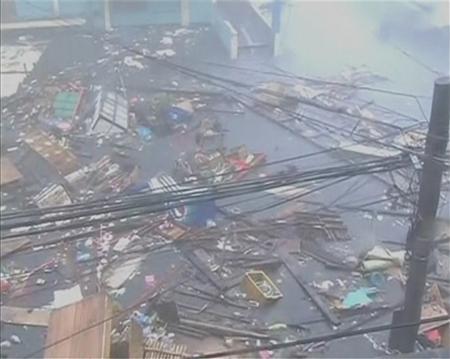(Reuters) – The strongest typhoon in the world this year and possibly the most powerful ever to hit land battered the central Philippines on Friday, forcing millions of people to flee to safer ground, cutting power lines and blowing apart houses.

Haiyan, a category-5 super typhoon, bore down on the northern tip of Cebu Province, a popular tourist destination with the country’s second-largest city, after lashing the islands of Leyte and Samar with 275 kph (170 mph) wind gusts and 5-6 meter (15-19 ft) waves.
Authorities warned more than 12 million people were at risk, including residents of Cebu City, home to around 2.5 million people, and areas still reeling from a deadly 2011 storm and a 7.1-magnitude quake last month.
The super typhoon likely made landfall with winds near 195 mph. This makes Haiyan the strongest tropical cyclone (typhoon) on record to make landfall,” said Jeff Masters, a hurricane expert and director of meteorology at U.S.-based Weather Underground.
Typhoons and cyclones of that magnitude can blow apart storm-proof shelters due to the huge pressure they create, which can suck walls out and blow roofs off buildings.
About a million people had taken shelter in more than 20 provinces, after Philippine President Benigno Aquino appealed to people in Haiyan’s path to evacuate from danger spots, such as river banks, coastal villages and mountain slopes.
Our school is now packed with evacuees, an elementary school teacher in Southern Leyte who only gave her name as Feliza told a radio station. Leyte and Southern Leyte are about 630 km (390 miles) southeast of the capital Manila.
The storm’s path includes the resort island of Boracay and other holiday destinations.
Please do not underestimate this typhoon. It is very powerful. We can feel each gust,” Roger Mercado, governor of Southern Leyte province, adjacent to Leyte, told DZBB radio. “We lost power and all roads are impassable because of fallen trees. We just have to pray.”
In Samar, contact was lost with some towns and villages, said local officials. More than 41,000 people have been evacuated in the province, one of the country’s poorest.
The whole province has no power,” Samar Governor Sharee Tan told Reuters by telephone. Fallen trees, toppled electric posts and other debris blocked roads, she added.
On Bantayan Island, off Cebu’s northern coast, one person was missing and another pinned beneath a tree, said Neil Sanchez, head of Cebu’s provincial disaster agency.
We still don’t know if the person was just injured or a fatality because the phone lines were cut, he said.
TORRENTIAL RAIN
Authorities halted ferry services and fishing operations, while nearly 200 local flights had been suspended. Commuter bus services were also stopped as the storm dumped torrential rain, ripped iron roofs off houses and snapped trees.
Twenty navy ships, three C-130 air force cargo planes and 32 military helicopters and aircraft were on standby. An army spokesman on southern Mindanao island said a man was killed in a shelter area when he was electrocuted by a toppled power line.
Schools, offices and shops in the central Philippines were closed, with hospitals, soldiers and emergency workers were preparing for rescue operations.
The state weather bureau said Haiyan was expected to exit the Philippines on Saturday and move towards the South China Sea, where it could become even stronger and threaten Vietnam or China.
The world’s strongest recorded typhoon, cyclone or hurricane to previously make landfall was Hurricane Camille in 1969, which hit Mississippi with 190 mph winds, said Weather Underground’s Masters.
An average of 20 typhoons slam into the Philippines every year. In 2011, typhoon Washi killed 1,200 people, displaced 300,000 and destroyed more than 10,000 homes. Haiyan is the 24th such storm to batter the Philippines this year.
Typhoon Bopha last year flattened three coastal towns on the southern island of Mindanao, killing 1,100 people and causing damage estimated at $1.04 billion.
In September, category-5 typhoon Usagi, with winds gusting of up to 240 kph (149 mph), battered the northern island of Batanes before causing damage in southern China.
(Additional reporting by Karen Lema and Erik dela Cruz; Editing by Jason Szep and Jeremy Laurence)





